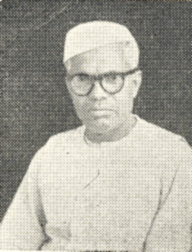C. Krishnan Nair on:
[Wikipedia]
[Google]
[Amazon]
 C Krishnan Nair (1902–1986) was an Indian politician of the Indian National Congress, an Indian Independence activist, a Gandhian who participated in the Salt March of 1930 and a
C Krishnan Nair (1902–1986) was an Indian politician of the Indian National Congress, an Indian Independence activist, a Gandhian who participated in the Salt March of 1930 and a
 C Krishnan Nair (1902–1986) was an Indian politician of the Indian National Congress, an Indian Independence activist, a Gandhian who participated in the Salt March of 1930 and a
C Krishnan Nair (1902–1986) was an Indian politician of the Indian National Congress, an Indian Independence activist, a Gandhian who participated in the Salt March of 1930 and a Member of the Indian Parliament
The Parliament of India (IAST: ) is the supreme legislative body of the Republic of India. It is a bicameral legislature composed of the president of India and two houses: the Rajya Sabha (Council of States) and the Lok Sabha (House of the Peo ...
of the First and Second Lok Sabha. He was popularly known as Delhi Gandhi or Nairji.
Early life and political career
Krishnan Nair was born in 1902 atNeyyattinkara
Neyyattinkara, is a Municipal Town and a major industrial and commercial hub located at the southern tip of Thiruvananthapuram metropolitan area in Trivandrum, the capital of Kerala State, and also the headquarters of Neyyattinkara Taluk. The ...
in Travancore state of British India (present day Kerala state) as the son of Shri Padmanathan. He received his elementary education at Neyyattinkara High School and Sri Moola Vilasam High School, Trivandrum.
He also received further education at Jamia Milla Islamia, Aligarh and Delhi.
After giving up his studies, he joined the Independence movement led by Mahatma Gandhi.
He had also worked as a teacher at the Indraprastha Gurukul, Faridabad and as a clerk at the Lakshmi Insurance Company.
During 1928 to 1930, he was a member of the Satyagraha Ashram at Sabarmati.
In 1930, Krishnan Nair was selected as a member of the first batch of 90 volunteers for the Dandi March, that later came to be known as the Salt Satyagraha of 1930.
After the Dandi March, he stayed at the Wardha ashram(later renamed as Sevagram).
In 1942, he participated in the Quit India
The Quit India Movement, also known as the August Kranti Movement, was a movement launched at the Bombay session of the All India Congress Committee by Mahatma Gandhi on 8th August 1942, during World War II, demanding an end to British rule in ...
movement.
Since 1943, he served as the Vice-President and Chief Public Relations Officer of the Delhi Pradesh Congress Committee
Delhi Pradesh Congress Committee (DPCC) is the Pradesh Congress Committee (state wing) of the Indian National Congress (INC) serving in the union territory of Delhi. Anil Chaudhary (politician), Anil Chaudhary is the president of Delhi Pradesh C ...
(DPCC) and as its President in 1952.
In 1952, when Delhi became a Part C State of India, Prime Minister Jawaharlal Nehru invited Krishnan Nair to become the first Chief Minister of Delhi as he was the senior leader of DPCC.
However, he refused and instead proposed the young leader Chaudhary Brahm Prakash
Chaudhary Brahm Prakash Yadav (1918–1993) was an Indian politician, the first Chief Minister of Delhi, also Called as sher-e-delhi, and a freedom fighter who played an important role in the individual Satyagraha Movement launched by Mahatma ...
, who was only 34 years old at the time, to become the first chief minister of Delhi.
In independent India, he served as the Member of Parliament (MP) representing Outer Delhi constituency in the First and Second
The second (symbol: s) is the unit of time in the International System of Units (SI), historically defined as of a day – this factor derived from the division of the day first into 24 hours, then to 60 minutes and finally to 60 seconds ...
Lok Sabha. During his two terms as MP, he was instrumental in setting up the Delhi Development Authority, and was an active member of various working committees such as for the Delhi Municipal Corporation Bill of 1957 and the Delhi Master Plan 1962.
When the Delhi legislative assembly was abolished in 1956 as per recommendations of the State Reorganisation Commission (SRC), he joined other key personalities of Delhi in strongly criticising the SRC. As the SRC effectively suggested to reduce the autonomy of the national capital to the level of a Municipal Corporation, he expressed his disappointment thus:
“But what we expected is a fair deal for Delhi just as every Part C State was added to Part A State, which means greater advantage and greater freedom for people of those areas. It is not so with regard to Delhi.”
As a senior Congress leader, he also mentored juniors such as Prem Singh who rose to take up important roles both in the party and government.
During his active political life in Delhi, he mostly lived in the Gandhi Ashram and the Narela area.
Death and legacy
Krishnan Nair died at RK Puram, New Delhi. The C.K. Nair Public School near Gandhi Ashram Road in Narela, Delhi is named after C. Krishnan Nair and was established in 1997.References
{{DEFAULTSORT:Nair, C. Krishnan Gandhians Indian independence activists from Delhi 1902 births Year of death missing India MPs 1957–1962